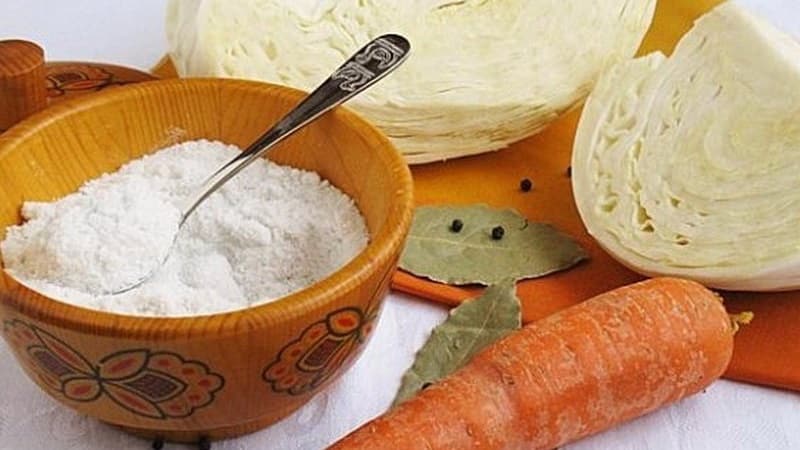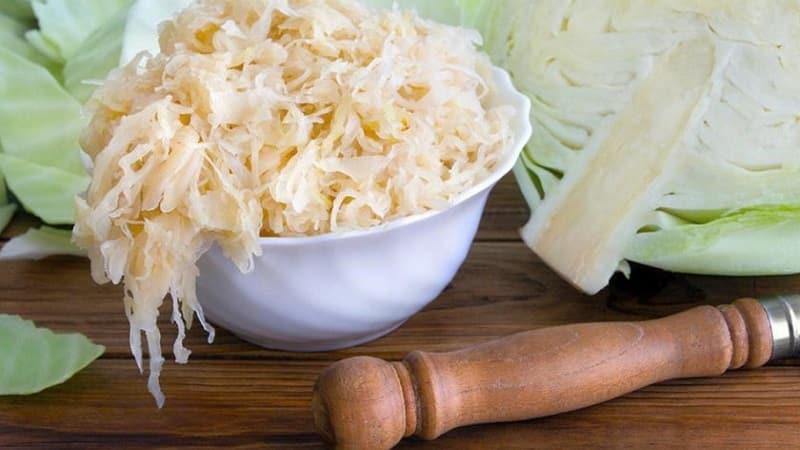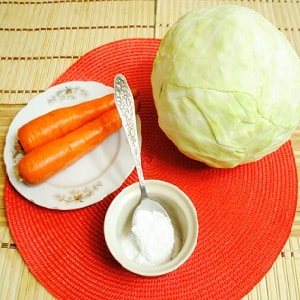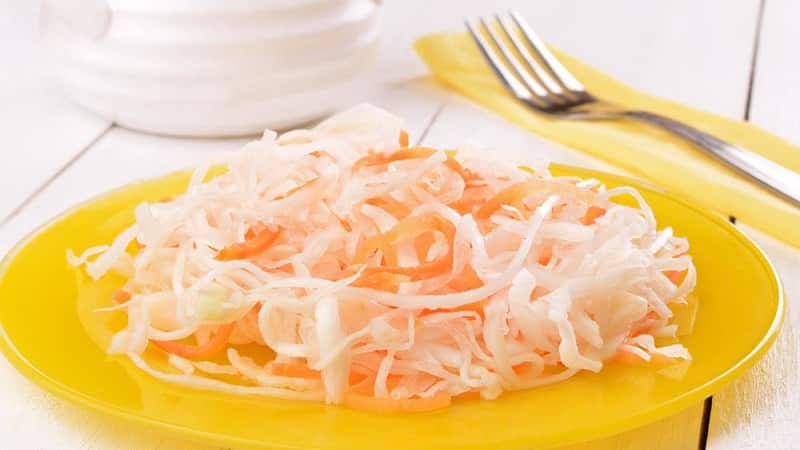How to calculate how much salt is needed per 1 kg of cabbage for pickling
Few people will refuse to try sauerkraut on the dinner or holiday table. This is a traditional dish, in the preparation of which the whole family used to participate.
In the modern world, housewives also make sauerkraut, but do not always maintain the correct proportions of ingredients. Therefore, we analyzed different recipes for the dish and found out how much salt is needed per 1 kg of cabbage for pickling.
How much salt is needed for 1 kg of cabbage when fermenting
If you look at old notebooks and notebooks with grandmother’s recipes, which many people keep in their kitchens, you can see the proportion: For 1 kg of cabbage take 25 g of salt.
In 1 tbsp. l. with a slide, 30 g of salt can be placed, and without a slide it will be approximately 25 g. You can measure it the old fashioned way, using spoons, but it’s better to use a kitchen scale.
According to the recipe, the bottom of the prepared dish is covered with a layer of rye flour., then covered with whole cabbage leaves. For taste, add carrots or apples, lingonberries or cranberries. Next, lay out the shredded cabbage, pre-mixed with salt. A circle (plate or wooden cutting board) is placed on top, and then a weight is placed.

Modern recipe books also say that For 1 kg of vegetable you need to take 25 g of salt. Over time, the proportions have not changed, the dish turns out delicious, just like in ancient times. In such recipes, it is suggested to chop the cabbage into strips 0.5 cm wide and rub with salt.Place whole cabbage leaves on the bottom, and chopped cabbage leaves on top, until the container is completely filled.
However in the brochure “Our Kitchen. Pickles and marinades” there is another tip: take 18-20 g of salt for 1 kg of cabbage. It is recommended to chop or chop the vegetable (optional), mix with salt. For taste, add carrots at the rate of 100 g per 1 kg of cabbage. Place the prepared vegetables in a wide container, and place a press on top. Leave for three days at room temperature, then stir and place in a cool place.
For 10 kg of cabbage
Based on the recommended proportions, the consumption for salting 10 kg of sauerkraut will be 250 g of salt (10 tbsp without a slide).
How salt consumption changes depending on the recipe
There is one rule in sauerkraut: The ratio of salt to vegetables is approximately 3%.
If you prefer lightly salted cabbage, you should take a smaller amount and vice versa, if you prefer highly salted cabbage, you should take a larger amount.
Which salt to choose
Grocery store shelves are filled with a variety of types of salt: sea, iodized, Himalayan, etc. But which one is most suitable for pickling cabbage? Let's answer this question in detail.
Food
The best option for pickling cabbage – use regular table salt. It comes without any additives and is sold in any grocery store at an affordable price. It is taken at the rate of 25 g per 1 kg of cabbage.

Marine
Table salt is good for sauerkraut, but it is a preservative. To enrich the dish with vitamins and minerals, sea fish is used in preparation. It contains more than 40 units of micro- and macroelements. It gives the finished sauerkraut a crunchy taste and prevents it from souring.
The taste of the finished dish does not depend on grinding, so you can take any of the options.
Iodized
Iodized salt differs from others in that iodine has been artificially added to it.
This is not recommended for sauerkraut.. Iodine prevents the development of lactic acid bacteria, which are necessary for the dish to have a sour taste, not to spoil, and for the finished sauerkraut to be crunchy.
By grinding
Depending on the grinding, salt is divided into two groups: large and small. The quality of the workpiece depends on the grinding.
Stone (large)
 This type is the most common. Its deposits are found in most countries.
This type is the most common. Its deposits are found in most countries.
Most often, salt is mined underground, at a depth of 1000 m. The mined giant blocks are crushed by combines and crystals of the required size are obtained. The largest crystals are used for industrial purposes, and the small ones - in cooking.
This salt contains a minimal amount of impurities and there is practically no moisture, which gives the substance a rich and pronounced taste.
Reference. Coarse (rock) salt consists of almost 100% sodium chloride.
Extra (small)
This salt is obtained from rock salt by bleaching with aluminum hydroxide and potassium ferrocyanide. These substances are necessary to prevent the formation of lumps.
Extra is not recommended for use in sourdough. In contact with water it can form a poisonous gas.
Choosing the right container
For pickling use different types of containers:
- Glass jar – in the case of small portions of workpieces.
- Enamel pan or bucket – for average volume of workpieces. It is important that the container does not have any damage to the enamel, otherwise this will lead to damage to the product.
- Clay or ceramic. This type of cookware must be glazed.
- Wooden tub, a barrel is a classic container for pickling.
Not recommended for use plastic dishes.
How to ferment cabbage the classic way
Before you start cooking, you need to properly prepare the vegetables. Carrots are added to add sweetness and a nice orange hue., but you can do without it. Usually it is taken at the rate of about 60 g per 1 kg.
Procurement rules:
- rinse vegetables and containers thoroughly and dry;
- use coarse salt;
- crush with a wooden masher;
- during cooking, pierce with a wooden skewer;
- use oppression.

Sourdough instructions:
- Wash the vegetables and chop them in any convenient way. It is better to use a knife with a large, wide blade, well sharpened, so that there are no uncut leaves in the finished dish.
- Grate the carrots on a coarse grater.
- Place cabbage in a wide saucepan and place carrots on top.
- Next, sprinkle with coarse salt.
- Using a wooden masher, mash the vegetables until the juices release.
- Place another layer of cabbage, carrots and salt.
- Mash with a masher until the juice comes out.
- Cover with a suitable lid.
- Place a weight on top. They can use a glass jar filled with water.
Leave it like this for three days. at room temperature. As soon as the pickling starts to foam, remove the press and remove the lid. Take a wooden stick or skewer and pierce it in several places. Repeat the procedure 2 times a day.
Important! Piercing the starter is necessary to release carbon dioxide. If you don't do this, the cabbage will turn out bitter and soft.
Place the finished pickling mixture in jars and store in a cool place.. Serve with chopped onions and generously sprinkle with vegetable oil.
Conclusion
Sauerkraut contains vitamins that the body lacks in winter. It is important for novice housewives to know what salt to choose and how much to put in to get delicious sauerkraut. Starting with a classic recipe for cooking, you can later diversify the table with appetizers of cabbage with cranberries or apples.